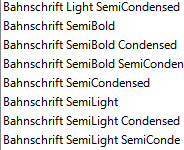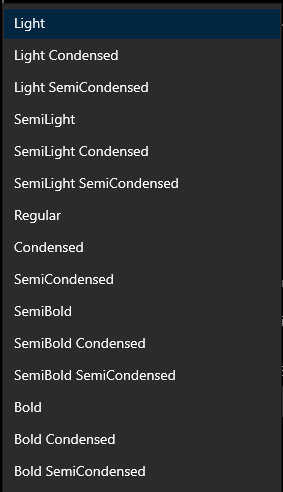It is admittedly a little quick and dirty, but I’m in the very very early phases of making a conlang. I came up with an orthography and used FontForge to make a font to be able to type it. Installed it just fine and I had the idea to make it be a kind of syllabary and have the vowels stack on the consonants. Design process over, I named it {language}-compressed and kept the family the same. When I installed it, windows just stacked it on the first iteration/“uncompressed” version. Cool! That’s probably exactly what I wanted even if I didn’t intend for it. Only problem is, I can’t figure out how to switch to it. When I look it up in my system settings it says my font has two faces. For the other fonts with multiple faces, this is things like bold and italics. For font families with other faces than those, they’re split off into separate entries in the font list (for want of a better thing to call it). Not so with mine. Obviously clicking bold or italics doesn’t produce it either and poking around in the settings I cannot figure out a way to get it to work. For the time being I just uninstalled my compressed version and saved it under a new family. I installed it and now it appears as a separate entry in LibreOffice. Which is functional and all, but I’d really love a way to figure out how to get this to work if such a way does exist. Help appreciated!
Windows 10, FO 7.4
Please edit your question (use the “pencil” tool hidden under …) to elaborate more. Don’t forget OS name, LO version and save format.
When you tell vowels stack on the consonants, do you mean you have implemented your vowels as “combining diacritical marks”?
How do the variants appear in the Font tab of any paragraph style (not the font drop-down menu in the toolbar)?
“Clicking bold/italics” or Ctrl+B/I is probably not relevant in your case as I suspect it will look for specific variant names. I would associate your variants with user-created character styles, to which a keyboard shortcut can be attached if needed.
More information is necessary about your fonts.
Out of curiosity, have you stored your glyphs in the PUA or have you replaced standard characters in the ASCII and Latin-1 areas (for ease of typing)?
What I did was make ligatures for all of the consonant-vowel pairs (e.g. b+a, b+e, etc.) and then it appears the same as the vowel on top of the consonant. So it’s basically just a ton of ligatures. I have bound them to standard characters with a few creative workarounds (like “S” = /ʃ/) since the inventory is not 1:1 with English, but I did want the ease of typing. That, by the way, did work the expected way if I tried to do a word beginning with small s at the beginning of a sentence with autocorrect on.
As for the variants, “Bahnschrift” is shown in my Windows font settings as having 15 faces, with every combination of “Light” “Semilight” “Bold” “Semibold” and “{regular}” “Condensed” “Semicondensed”. Except for Bahnschrift Bold, these are all shown in the dropdown menu as “separate” fonts to select. Which is how I would have expected it to maybe handle mine, but it did not.

(I cannot fit all of the variants but this is how they appear)

(it will not let me put 2 images in one post) this is how it looks in Windows as “font faces”
Your ligature trick is bright!
I understand that you modified Bahnshrift in fact. Have you also tweaked the various description tables with FontForge? This is where you can make a distinction between variants. If your file is not too big, attach it to some comment so that I can have a look to it.
I was just using Bahnshrift as an example of font faces other than bold and italics and how LO handles them. I can attach my .otf files if you want to look at them, but I made the fonts up from scratch, they do not resemble English at all. (They also happen to be not finished, the spacing can be a bit weird, especially)
I am just interested in the description tables, not the glyphs by themselves. I want to check the consistency of these tables.
